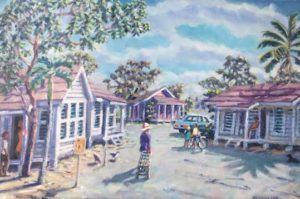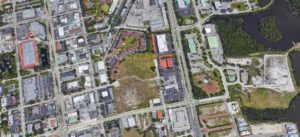McDONALD’S QUARTERS

Jeff Lytle
Say “McDonald’s Quarters’’ in Naples today and people might think you mean quarter pounder burgers under the Golden Arches. Those people were either not here or do not want to remember what McDonald’s Quarters really meant for four decades until 1981.
That is when the infamous shantytown slum in Central Naples – whose five-acre site is now some of the hottest real estate in the city – was torn down. A court found it unfit for human habitation, and a non-profit made repairs until new housing was ready nearby.
The specter of the quarters comes back to life now thanks to an original oil painting by prominent artist Paul Arsenault, who specializes in far prettier landmarks. Recently he was invited to take part in a local art exhibit touching on black history, and he remembered a painting he made of McDonald’s Quarters in 1979 – only a week before it was set to be torn down.
 He offered a high-quality copy for a February auction – at a $200 a plate NAACP gala at a beachfront resort – as a prelude, with the long-range goal of getting the original into the Collier County Museum network, preferably at the Naples Depot branch only nine blocks from the quarters site. The image fetched $5,000 for the NAACP from Bill Dwight, the Friends of the Museum leader who serendipitously attended the banquet. Arsenault’s goal gained some nice momentum.
He offered a high-quality copy for a February auction – at a $200 a plate NAACP gala at a beachfront resort – as a prelude, with the long-range goal of getting the original into the Collier County Museum network, preferably at the Naples Depot branch only nine blocks from the quarters site. The image fetched $5,000 for the NAACP from Bill Dwight, the Friends of the Museum leader who serendipitously attended the banquet. Arsenault’s goal gained some nice momentum.
THE HISTORY
McDonald’s Quarters comprised 99 units in 55 duplexes and stand-alone shacks. Chickens roamed free.A community task force in 1975 found rampant violent crime, disease, stench from raw sewage, fire hazards, illiteracy, drugs, bugs and despair among 600 to 700 people crammed into homes averaging 400 square feet. The report could find no policing of original construction materials or standards. It was a slum by design.

Calling it “morally wrong and indefensible,’’ the property known as “McDonald’s Colored Quarters’’ in official city records from 1958 was labeled “a cancer.’’ A retired police chief calls it “Naples’ shameful ghetto.’’ It started as the Sawmill Quarters around 1950, named for a big nearby employer.
THE MCDONALD FAMILY FROM FORT MYERS BUILT THE QUARTERS
– then constantly refused to make repairs, except for once in 1971. The circuit court eventually condemned the shacks – with a forerunner of Habitat for Humanity handling repairs at the renamed Progress Village until replacement apartments could be built nearby. (Proceeds were later put toward the first Habitat houses in Immokalee.)
Historian Lodge McKee was named to the city created Carver Finance Corp. to guide the new apartments. He remains in that volunteer role today. He recalls once running an errand and driving into the quarters by mistake. “I felt like I no longer was in Naples,’’ he said of the “sad little shacks that had not seen a bucket of paint in years.’’ “It was something out of the Deep South.’’ Or Third World.
Dave Rynders, the city attorney who lobbied Washington for money to build the George Washington Carver Apartments, says: “I can’t even imagine slaves living like that.’’ Then he adds, “But it’s a terrific spot today.’’
 Indeed. The site now is bounded by the Neighborhood Health Clinic and Fun Time Early Childhood Academy to the east, and Jasmine Cay apartments to the northwest. It is part of the chic Eleven-Eleven condo project in progress with units starting at $700,000; the other part hosted the Naples Daily News from
Indeed. The site now is bounded by the Neighborhood Health Clinic and Fun Time Early Childhood Academy to the east, and Jasmine Cay apartments to the northwest. It is part of the chic Eleven-Eleven condo project in progress with units starting at $700,000; the other part hosted the Naples Daily News from
1969 to 2009. Both pieces, totaling 8.5 acres, were purchased by the condo developer for $15 million last year. Also in the highend neighborhood are Naples Square and several design centers.
The quarters included three or four bars with names like Rabbits, The Juke, Dew Drop Inn and Miss Lillie’s Green Top (or Spot) Social Café, where Kevin Rambosk, now sheriff of Collier County, remembers having a midnight snack on his very first shift as a city cop. He says the proprietress handled miscreants herself – then called police.
Gary Young, the police chief as the quarters ended, remembers the Sanctified Church. “On prayer meeting Wednesdays, the music literally shook the small building on its foundation,’’ Young says. “Little Richard would’ve fit right in.
Great music.’’
Jerry Pugh has a special perspective. He moved to Naples as a little kid and lived in McDonald’s Quarters as well as the River Park Apartments next door – across the tracks from a rail spur serving the sawmill. Pugh in the late 1960s was among the first black students allowed at Naples Junior High School (now Gulfview) and then Naples High School. He went on to become a popular cameraman for local cable TV and wound up covering the ugly yet welcome demise of the quarters. “Most newcomers have no idea how things were here,’’ he says.
Which brings us back to the Paul Arsenault painting that rekindled all these memories. “I wanted to document it,’’ he says, adding he is pleased to be part of a fundraiser for the NAACP and a possible black history art exhibit next year – and maybe get that original painting into the county museum.
High bidder Bill Dwight concurs: “I think it is an important topic that should be in a museum collection.’’
(Ross W. McIntosh & Associates helped research land transactions for this story.) Jeff Lytle is the retired editorial page editor and TV host for the Naples Daily News.



What happened to the African American community that lived in the Quarters? Has the community been “gentrified”? Does Naples remain essentially racially segregated? I grew up there but have only returned to visit during the last two decades.